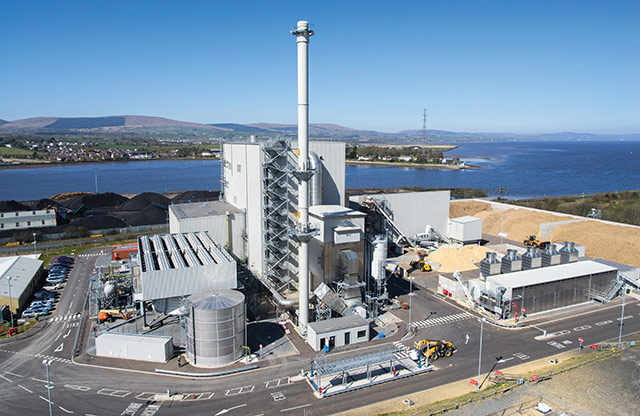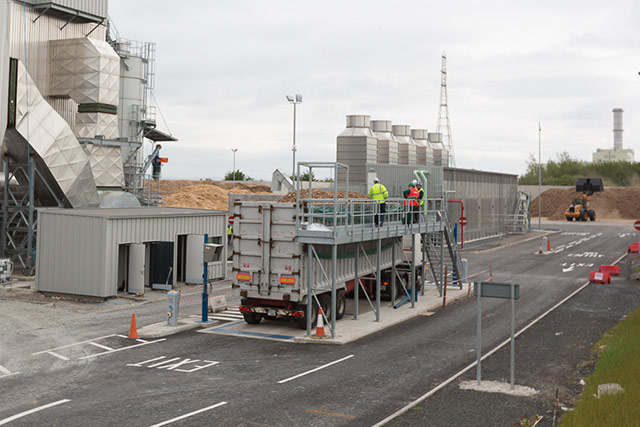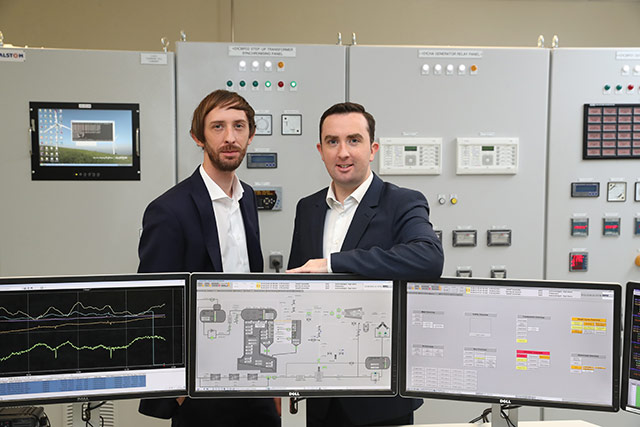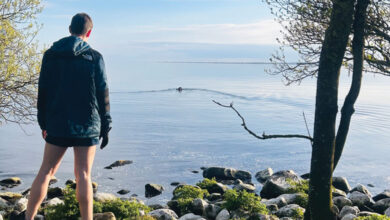Evermore Energy: Efficiently powering the future
Less than a year into operations of Northern Ireland’s largest Combined Heat and Power (CHP) biomass plant, Derry-born brothers Stephen and Ciaran Devine have already turned their attention to future projects, with plans underway to develop and build Northern Ireland’s most efficient power station at the Belfast Harbour Estate.
Through a combination of generation and storage projects the brothers are convinced that not only will the lights stay on in Northern Ireland after 2020, but they will stay on efficiently.
Standing atop Evermore Energy’s 15.8MW power station in Lisahally, a 10-acre site overlooking a variety of businesses also located on the Londonderry Port and Harbour Commissioners’ land, most notably the LCC Group coal processing facility, it is hard to escape the irony in the close proximity of the two very different fuels used to generate electricity here in Northern Ireland. The Devine brothers have a clear passion and plan for dramatically reducing Northern Ireland’s carbon footprint, one element of which is creating alternatives to the burning of fossil fuels to generate electricity. However, the current complexities of Northern Ireland’s electricity generation are not lost on Ciaran who, remarks “right now it takes all types to guarantee the security of supply”.
The Lisahally plant is an example of the type of alternatives they are offering. Over the course of its 20-year lifetime, the project is expected to divert around two million tonnes of wood earmarked for landfill to create electricity, increasing Northern Ireland’s renewable energy generation by circa 10 per cent. The benefits of the project are two-fold. As well as burning recycled woodchip to generate electricity for the grid, the excess heat is also used to dry virgin woodchip, essential for smaller biomass boilers in commercial and domestic properties capitalising on the benefits of the Renewable Heat Incentive (RHI).
Qualified stockbroker and former financial adviser with Jones in London, Ciaran (33) explains that the plant is the first energy project that he and younger brother Stephen (32), a former Ulster University and KPMG employee, have embarked upon having arrived at the concept of the project in early 2010.

“We take a huge amount of pride in our Lisahally station, taking it from concept to a generating unit which is feeding green energy into the grid on a 24/7 basis.”
“Stephen and I always had an interest in business and we were focused on developing a successful venture together,” he says. “In the midst of a recession we were cautious of anything property related and the energy market has always interested us. At the time there was a lot of activity in the wind sphere and we wanted an alternative to address the 15 per cent renewable energy target from non-wind sources. After a lot of research into biomass generation we visited the Western Wood Biomass Plant situated in Port Talbot, Wales, a concept that we then looked to expand and develop.”
Planning for the site was submitted in 2010 and approved six months later. Stephen says that the brothers then set about establishing a basket of necessary contracts, licenses and permits before approaching potential investors in late 2011. The project achieved financial close in July 2013 and, following a two-year construction programme, the plant was handed back to them in September of last year.

“We put together back-to-back contracts for the project and really focussed on what would be acceptable from a project finance perspective at an early stage.”
Evermore, advised by KPMG Corporate Finance Belfast, secured the £81 million of funding from the UK Green Investment Bank through Foresight Group’s managed fund, UK Waste Resources and Energy Investments. Partner funders also included GCP Infrastructure Fund Ltd, Burmeister & Wain Scandinavian Contractor A/S (BWSC), Investec Bank, and Eksport Kredit Fonder. The Scandinavian firm (BWSC), who were responsible for engineering, procurement and construction, will also be responsible for operation and maintenance of the plant for the next 15 years. Stobart Biomass Products has been long-term contracted to provide woodchip to the project, at least 40 per cent of which will be from Northern Ireland, while Power NI has agreed to purchase all of the electricity produced.
Despite acknowledging that a project of such magnitude involved a high level of risk, Stephen said that he and his brother were always confident they had the right skillset to make the project successful. “We put together back-to-back contracts for the project and really focussed on what would be acceptable from a project finance perspective at a very early stage. We took the risk out of everything we could or we found suitable counter parties that could support the project and who would be comfortable carrying different elements of risk. One example is the low price of electricity at the moment, that’s an investment risk, but that risk is balanced by the longevity of the project and the long-term deals we have put in place,” he says.
For the brothers, locating the power plant within the North West was key. Ciaran adds: “In the middle of a recession there was a lot of unemployment in the construction industry and we always set out to ensure that, providing the right things were in place, we could create jobs in the North West.” The project created over 250 jobs during its construction period,
18 permanent jobs and 50 additional jobs in general transport and processing.
“A huge part of the station’s success lies in the support we received from Londonderry Port & Harbour Commissioners who were very open to the idea of us importing fuel and leasing us the land. It allowed us to prove that if we ever had issues accessing fuel here in Northern Ireland then it could be brought in by ship,” he explains.
“That proved key when we were going out into the market to raise project finance because they liked that our supply market wasn’t limited. There was a good synergy between ourselves and the Port, they recognised the importance of the project and its ability to develop their business, while we know from research that biomass projects located near ports have the best success rate.
“Another key element of the plant’s location is its accessibility to the grid and our ability to export electricity unobstructed. Our own on-site substation handles the electricity for NIE to take it over to the Coolkeeragh unit, which is less than 1km from the site, and it is then dispersed across the North West.”
It was while accessing the grid that the brothers decided to develop another of their projects, two 50MW energy storage (battery) plants to be located at Lisahally. Stephen explains: “Energy storage demand is being led by mass quantities of onshore wind in the North West. Understanding the constraints on the grid for our own project we recognised a need to maximise wind energy in the North West and to provide reactive power to the grid. We’re seeing the cost of the technology being driven down, similar to what happened with solar a few years ago, and the software is constantly being improved to maximise efficiency.”
Ciaran adds: “Essentially we looked at the grid in its entirety and identified the weaknesses and the need for investment to provide stability and make better use of how Northern Ireland is generating electricity. The overall demand doesn’t always marry up with the huge levels of wind generation in the West and this technology will smooth out some of those fluctuations and grid patterns. In that sense we believe that the North West is the best strategic site for the energy storage project.”
The success of Lisahally has encouraged Evermore to take on their biggest project to date with a planning application soon to be submitted for Northern Ireland’s “largest and most efficient” gas-fired power station in the Belfast Harbour Estate. Located less than 2km from the gas connection into Northern Ireland, the 480MW station is to be operational by 2020 and will make up a large percentage of the generation that will be lost through the retirement of the Ballylumford and Kilroot units.
A cap on the availability of woodchip and a greater volume of demand in Belfast meant that replicating the Lisahally station was never going to be a viable option, however, Ciaran states that the efficiency of the project will not only address the demand requirements in Northern Ireland but will place it as a leading competitor under the Integrated Single Electricity Market (I-SEM).
“It delivers a message to the rest of the world and to anyone potentially offering Foreign Direct Investment (FDI) that we are making serious decisions and investing in the future of electricity generation here in Northern Ireland,” he says. “Naturally I-SEM will reward the most efficient plants with a higher merit order because it is reducing the cost to the consumer, which is a priority to the grid. Essentially I-SEM will want the most efficient plants on first and together with Siemens our technology partner we are focussed on maximising the efficiency of the new Belfast Power Station.
“Another major electricity project in the planning system is SONI’s proposed North South Interconnector. It will allow the full implementation of the SEM and subsequently the I-SEM. It is very important this is delivered but its timescale doesn’t affect the development of our Belfast Power Station. Secure and highly efficient gas powered generation is needed in Northern Ireland anyway.”
“…together with Siemens our technology partner we are focussed on maximising the efficiency of the new Belfast Power Station.”
For its Belfast project, Evermore received a multi-million pound investment from Northern Ireland’s largest venture capital fund, Crescent Capital and has developed a close working relationship with Belfast Harbour Commission.
Construction for the project, which will use the latest Siemens gas-fired technology, is expected to begin at the end of 2018 meaning the project should be operational by 2020. Over 700 construction jobs are expected to be created during the £280 million investment and discussions about a further storage unit in Belfast are in their early stages.
Stephen says that the rapid progression of their projects has been aided by close working relationships and the proactive approach from the Department for Infrastructure (DfI), the Northern Ireland Environment Agency (NIEA), the Utility Regulator, SONI and Northern Ireland Electricity (NIE). “Everyone can see the benefits of good projects on a wider basis and good projects gather good investment and support,” he adds.
Summarising their progress to date Ciaran says: “We take a huge amount of pride in our Lisahally station, taking it from concept to a generating unit which is feeding green energy into the grid on
a 24/7 basis. Providing electricity to around 30-35,000 homes in our own locality, while creating jobs locally to construct and run the plant gives us great satisfaction.
“We’re driven by improving the Northern Ireland energy market. When we started out there was a small degree of pessimism around the idea and comparisons to what had already been done in Europe but now Northern Ireland has its own biomass project and is going to have the most efficient power station in the UK and Ireland, meaning we will soon be seen as a leader in terms of energy.
“We’re proud that Evermore Energy is at the cutting edge in this new era of electricity generation and storage in Northern Ireland and our ambition is to help develop one of the best networks in Europe.”






